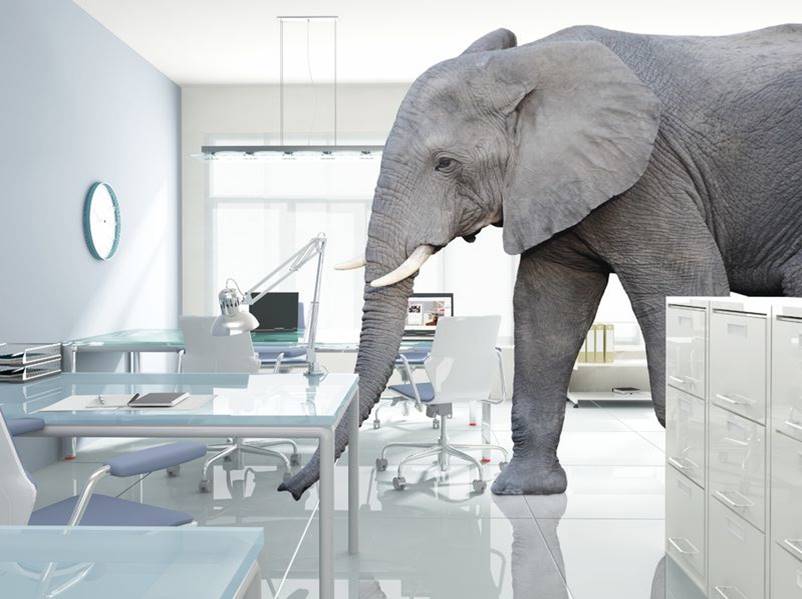Conflict is a growth opportunity.
Conflict is an opportunity; for you, your team, your organization. Address the elephant in the room. Make conflict your strategic advantage. Grow through conflict. I’ve written this short story (3 minute read) to illustrate.
—————-
Let’s start with the end, in mind.
Picture this: You are climbing onto a stage, to receive the ‘Best Workplace’ award. Feelings of gratitude wash over you.
With the award in your hand, your first words express humility, “On behalf of my company, we are humbled to receive this award, in recognition of our positive, collaborative workplace. You know – we weren’t always this way.”
Then, you unfold your company’s story.
Five years ago
“Five years ago, knowing that workplace conflict is inevitable, we challenged ourselves to deal better with conflict. We wanted to turn conflict into our strategic advantage.
We knew that when we handled conflict well, good things happened. Cooperation increased. Silos came down. Employee engagement, workplace productivity and customer service improved.
On the other hand, we’re only human. Feelings, too often, surfaced that weren’t our better selves, leading us down an unhealthy path.
Miscommunication was prevalent. “The single biggest problem in communication is the illusion that it has taken place.” George Bernard Shaw’s words rang true.
And, when the negative emotions combined with misunderstanding, miscommunication, we had a tried-and-true recipe for conflict.
Individual successes
Along the way, we had individual successes; employees who aspired to deal better, with conflict, and did. For example, Sara:
Sara, who is now one of our top employees, and a role model for me, didn’t start off that way.
Looking back, her fear of conflict, and authentic conversation, was a drag on her, and her work colleagues.
Proactively, Sara took it upon herself, to increase her self-awareness, to dial-in, tune in, to her conflict behaviours and hot buttons. As a result, she began making better choices; choosing constructive behaviours, that deescalate conflict, over destructive behaviours, that escalate conflict.
As her ability to express her feelings, and actively listen expanded, Sara no longer avoided difficult conversations. She gained a reputation, as a peer support, conflict coach, and leader, by example.
Little by little, her contributions accumulated, and refreshed us. Everyone wanted Sara on their team. In fact, we wanted more people to act, as Sara did. Unfortunately, our culture wasn’t up to the task. Something was missing.
Building a culture of constructive behaviour
As our organization wrestled with how to scale constructive behaviours, the 2017 Hays Report came out. It showed what people wanted. Workplace culture was at the top of the list; a culture characterized by open communication and strong leadership. Bingo! We had our cues.
Then reality hit us. Open communication requires open constructive conflict. When it comes to Difficult Conversations, most of us preferred to leave the elephant in the room. We’d rather not deal with our differences, directly.
To help, we focused on our core values, such as mutual respect. In The Culture Engine, consultant/author Chris Edmonds advises making your intentions around culture explicit, and clear; e.g., “I show respect to co-workers and customers by listening without interrupting” was one of four behaviours we defined, for mutual respect.
Through feedback, we measured people on their behaviours; how well they aligned with our core values.
Culture starts at the top. For our leaders, we expected a bit more. We wanted them to spend 50% of their time managing for results, and 50% managing the quality of workplace relationships and interactions. 50-50 leaders walk the values talk.
At all levels of the organization, what we didn’t want were peak performers whose behaviours didn’t align with our values. Leadership expert, Patrick Lencioni, in The Ideal Team Player, refers to high performers whose values don’t align, as “jackasses”. We created our own ‘No Jackass’ Rule. We share our jackasses with the competition.
Scaling constructive behaviours for strategic advantage
Gradually, constructive behaviours became the norm in the company, part of our cultural DNA. We embedded constructive behaviours into our employee hiring, assessment and development processes.
Lo and behold, employee engagement and loyalty went up. Workplace productivity went up. Customer service went up. The best people wanted to work for, and with, us.
Five years ago, we feared conflict. Today, we embrace conflict. We measure ourselves through conflict.
Conflict is our strategic advantage.
Why not make it yours, too!”
The above story is framed in a 5-minute talk I gave at, Your Conflict Advantage, to an auditorium full of HR folks, at the 2017 Disrupt HR event in Victoria. Here’s the video of that talk:

